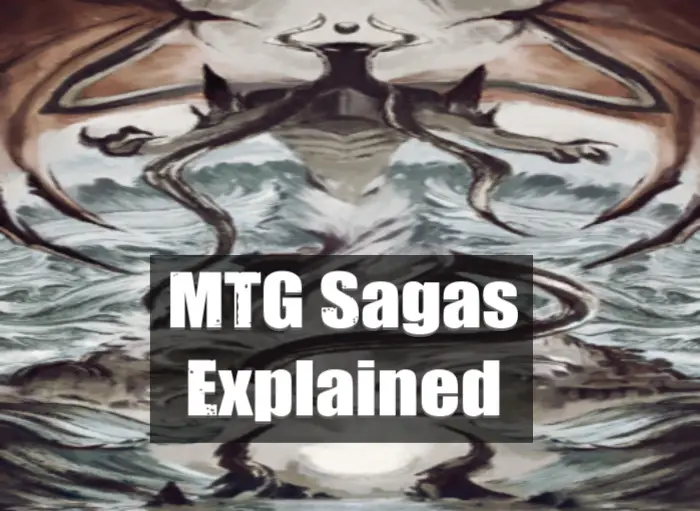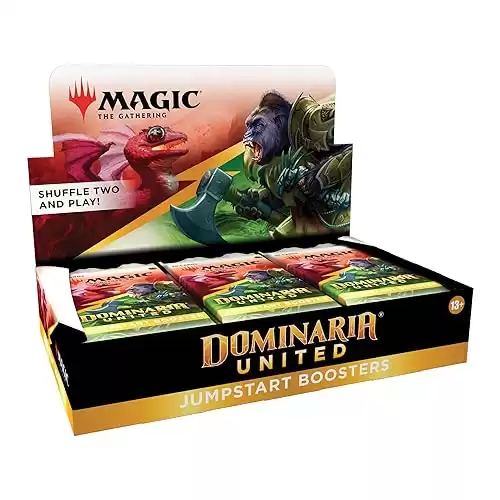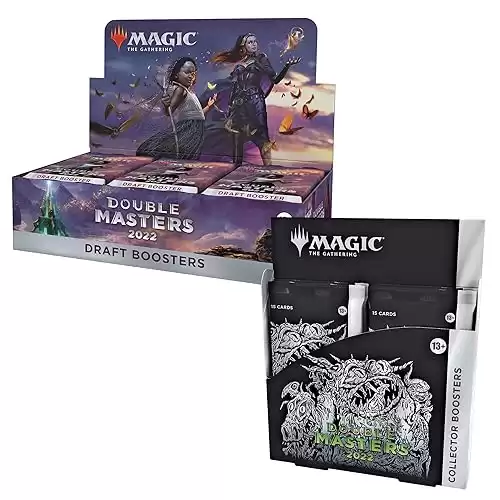It’s not often that WOTC will completely rethink how Magic cards work, but they can create some amazing designs when they do. A saga is a special kind of enchantment that doesn’t function quite like anything else in MTG. They immediately became a fan favorite and have appeared numerous sets.
Sagas are a subtype of enchantments that have their own special set of rules. Each saga has chapter abilities that are listed next to roman numerals. Whenever you put a lore counter on that saga, you trigger the next chapter ability. After the last ability resolves, you sacrifice the saga. These cards are meant to tell a story through gameplay, and they are a deciduous mechanic which WOTC uses fairly often.
New and old players alike often have questions about how exactly these unique enchantments work. Luckily for you, I’ll be breaking down sagas in three acts: we’ll begin with what exactly they are, explore the details of how they work, and conclude with the best sagas that you should be running!
| Pros | Cons |
| Multiple effects | Delayed effects |
| Lots of synergies |
Table Of Contents:
What Is A Saga in MTG?
Sagas are a subtype of enchantments, but they work in a completely unique way.
Most enchantments will have the same effect throughout the game. Some cards, such as Favorable Winds, just have a static ability. Others, like Ajani’s Welcome, might have triggered or activated abilities. These abilities are constant, and enchantments will typically stay on the battlefield until a player removes them.
Sagas, on the other hand, have a variety of effects. Each saga has a set number of chapters that trigger when you place lore counters on them. These abilities could be wildly different, and a saga might not repeat the same effect twice. Sagas also sacrifice themselves after their last ability resolves, so they leave the battlefield on their own.
Rather than have a set effect on the game like typical enchantments, sagas tell their story and leave once it’s finished.
How Does a Saga Work in MTG?
Sagas are a lot more complicated than the average enchantment, so there are plenty of common questions players have about them. Let’s take a closer look at how exactly sagas work, and how you can interact with them to get the most value possible.
How Do You Use a Saga in MTG?
You don’t actually have to do anything special to use sagas. You don’t have to spend mana or jump through hoops to activate their abilities; they’ll happen naturally as the game progresses.
When you put a lore counter on a saga, the corresponding chapter ability will trigger. That means the first chapter will trigger with the first counter, the second will trigger with the next counter, and so on.
The saga will also get lore counters on its own. When a saga enters the battlefield, it has one lore counter on it already. That means that the first chapter ability will trigger as soon as you play it. After that, you’ll put a lore counter on it at the start of your first main phase each turn. Once the saga’s final chapter has resolved, you have to sacrifice it.
Can You Proliferate Sagas in MTG?
Yes! As long as the saga has at least one lore counter, you can proliferate it to trigger the next chapter ability. Since sagas normally follow a strict schedule, this is a great way to throw your opponents off.
Kepe in mind: chapter abilities only trigger when there are the right number of counters on the saga. If you add a fourth counter to a saga that only has three chapters, you don’t get the final ability again. In fact, you’ll sacrifice the saga right away, instead of after the final ability resolves.
“If the number of lore counters on a Saga permanent is greater than or equal to its final chapter number, and it isn’t the source of a chapter ability that has triggered but not yet left the stack, that Saga’s controller sacrifices it. This state-based action doesn’t use the stack” (715.4)
MTG Wiki
RELATED: MTG Proliferate: How Does It Work?
Does Stifle Counter a Saga in MTG?
Yes! Chapter abilities are just triggered abilities, so counterspells like Stifle can still counter them.
You can’t ever use Stifle to stop a saga from getting a counter, though. The saga enters the battlefield with the first counter on it, so you’d need to just counter the saga itself. After that, the saga gets another lore counter at the beginning of it owner’s first main phase. This is a state-based action, which doesn’t use the stack. You never get priority, so you can’t cast spells or activate abilities.
Does Removing a Counter from a Saga Trigger It?
No. Sagas only trigger when you put a lore counter on them, not whenever the number of lore counters changes. Of course, you still delay the final chapter, and you’ll get to use one of the chapters an additional time.
Is a Saga an MTG Permanent?
Yes! They’re still enchantments, which are a kind of permanent.
What Happens When You Copy a Saga in MTG?
If you copy a saga, the copy won’t have the same number of lore counters as the original. Instead, it’ll enter the battlefield with one lore counter on it, just like any othe saga. From there, it’ll get lore counters at the start of your main phase, and get sacrificed after its final chapter resolves.
Can You Target a Saga Before Sacrificing It in MTG?
Yes! When a saga’s final chapter ability goes on the stack, the saga is still on the battlefield. You don’t have to sacrifice it until after that ability resolves, so you can still target the saga.
One of the best ways to use this rule is to return the saga to your hand. That way, you get to play the saga again instead of sending it to the graveyard.
Best MTG Saga Cards
Now, onto the finale! You’ve learned what sagas are and how they work, so let’s apply that knowledge to see which sagas are the best.
#8: Kiora Bests the Sea God
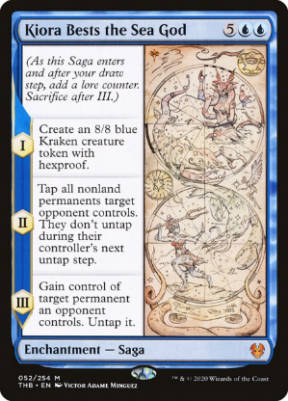
Kiora Bests the Sea God is tough to cast, but its effects can swing the game in your favor. Making a huge, hexproof threat is strong on its own, but the next two chapters keep the pressure on. Seven mana is a lot, though, especially for a card that doesn’t win the game on the spot. You’ll need to run plenty of ramp alongside this saga.
| Pros | Cons |
| Three powerful chapters | Very expensive |
Recommended Formats: Commander
#7: Binding the Old Gods
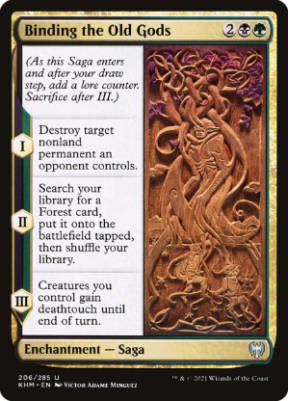
Binding the Old Gods is a personal favorite of mine. Removal and ramp are just generically good effects, and giving your creatures deathtouch could make things awkward for your opponents. Of course, four mana isn’t efficient for single target removal. If you’re not getting at least the first two chapters, you’re not getting your mana’s worth.
| Pros | Cons |
| Removes anything | A bit expensive |
| Good value |
Recommended Formats: Commander, Pioneer
#6: Showdown of the Skalds
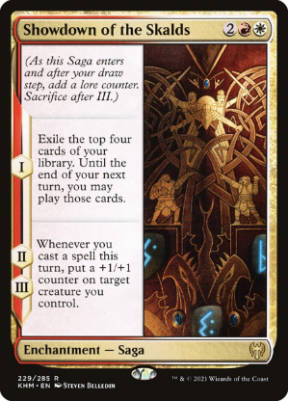
Boros doesn’t usually get much card advantage, but Showdown of the Skalds is a fantastic option. Looking at four extra cards is great, and you get two turns to play them. If your opponents don’t remove the Showdown, you even get +1/+1 counters just for casting spells.
This saga’s biggest downside is that it doesn’t do much right away. Usually, you want sagas to have a good ability right when you cast them. Even though Showdown of the Skalds‘ first chapter is its best, you likely won’t play a ton of cards with it until your next turn. It takes extra time to get your value from this card, and other sagas reward you immediately.
| Pros | Cons |
| Card advantage | Slow |
Recommended Formats: Commander
#5: Song of Freyalise

In decks that go wide, Song of Freyalise is explosive. You can use the extra mana from your creatures to play even more creatures, and repeat that process on your next turn. If you get to the third chapter, your
The final chapter really pushes Song of Freyalise to the next level. With indestructible and vigilance, there’s no downside in attacking with everything. The +1/+1 counters and trample also mean you’ll push through lots of damage. If you can set up the right
| Pros | Cons |
| Tons of ramp | Needs you to have creatures |
| Gives you a great attack |
Recommended Formats: Commander
#4: Elspeth’s Nightmare
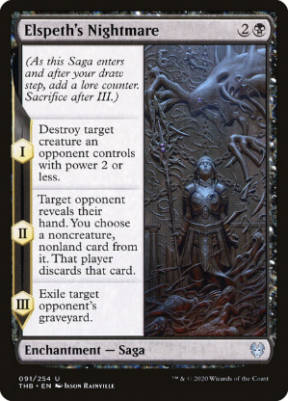
Elspeth’s Nightmare isn’t good against every deck, but it can be frightening in the right matchup. Each of its chapters either have limitations or niche effects; however, they all combine into an efficient package.
For just three mana, you can disrupt your opponents’ plans in a lot of different ways. This works especially well in Commander, where you can use each ability against the player its best against. Maybe one player has a Blood Artist you need to remove, and another is stockpiling their graveyard. As long as you play it in the right situation, Elspeth’s Nightmare will work like a dream.
| Pros | Cons |
| Efficient | All chapters are situational |
Recommended Formats: Commander
#3: The Eldest Reborn
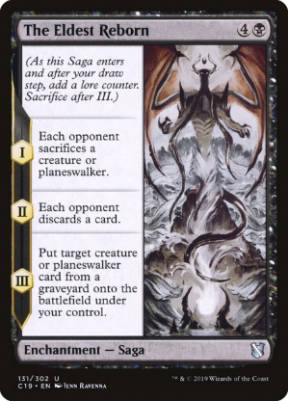
Usually, you want sagas to have a strong effect right away. The Eldest Reborn only makes your opponents sacrifice a creature or planeswalker, and there are much better effects for five mana. Discarding a card also doesn’t justify that high mana cost. If you can get the final chapter to resolve, though, The Eldest Reborn is amazing. The reanimation effect can give you a huge advantage, especially since the first two chapters give you more options to choose between.
| Pros | Cons |
| Removal | Expensive |
| High ceiling | Best chapter is last |
Recommended Formats: Commander
#2: Elspeth Conquers Death

Elspeth Conquers Death makes a big difference in just about any position. Exiling your opponents’ best card is amazing, and so is reanimating your best creature or planeswalker. The second chapter might be more situational, but every deck runs at least some noncreature spells. This saga helps you catch up when you’re behind or push through when you’re ahead. It might cost a lot, but you’re paying for versatility and three great abilities.
| Pros | Cons |
| Removal | Expensive |
| Three strong chapters |
Recommended Formats: Commander
#1: Urza’s Saga
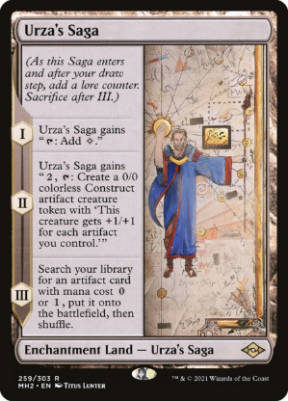
Urza’s Saga is the strongest and most powerful saga ever printed. It’s also a land, so you don’t have to spend any mana to play it. It also doesn’t do anything special on its first turn: it just taps for mana like any other land. Getting the next two abilities off of a land, however, pushes Urza’s Saga to the top of the list.
The best chapter is the last one. One of the best things you can do in Magic is tutor, and there’s no shortage of cheap artifacts worth finding. Whether you’re getting Colossus Hammer or a cheap mana rock, you should be finding one of the best cards in your deck. It’s dangerous to play a land that sacrifices itself, but the payoff is more than worth the risk.
| Pros | Cons |
| Artifact tutor | Temporary land |
| No mana cost |
Recommended Formats: Commander, Legacy, Modern
End Step
And now my tale comes to a conclusion. We’ve gone over how to use sagas and which ones are worth a slot in your deck. Playing a saga is a unique experience in MTG, and I hope you’ll try them out for yourself.
